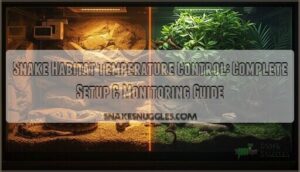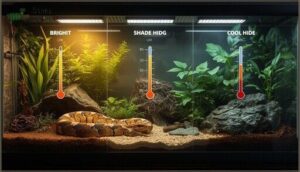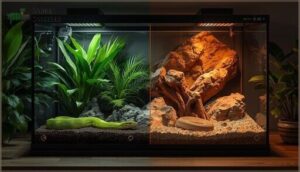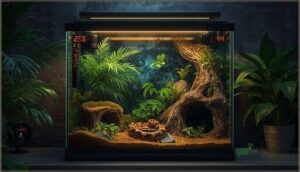This site is supported by our readers. We may earn a commission, at no cost to you, if you purchase through links.

A snake’s world runs on temperature. Miss the mark, even by a few degrees, and you’ll see the difference: sluggish, stressed, or biting at shadows. Metabolism, immune strength, and even the shine of a fresh shed depend on getting those numbers right.
Each species draws its line—vipers in the cool shade, pythons on sunbaked stones—so a generic setup cuts corners on their health.
With true temperature control, you create comfort, routine, and safety. If you want your snake to thrive instead of survive, it all begins with how you shape and monitor the heat in their habitat.
Table Of Contents
Key Takeaways
- Snakes rely completely on their enclosure’s temperature gradient to regulate metabolism, digestion, and immune health.
- Accurate, species-specific temperature control—with warm, cool, and basking zones—is essential for your snake’s well-being and routine.
- Thermostats, digital thermometers, and regular monitoring prevent health problems caused by overheating, chilling, or sudden temperature swings.
- Reliable heat sources, correct probe placement, and precautions against burns and power loss are key to a safe, stable habitat.
Importance of Temperature Control in Snake Habitats
Temperature control isn’t just a nice-to-have for your snake—it’s the foundation of their health. Snakes can’t generate their own body heat, so they depend entirely on their environment to function properly.
Understanding why temperature matters, what happens when it’s wrong, and how different species have unique needs will help you create a habitat that keeps your snake thriving.
Why Snakes Need Thermal Gradients
Snakes depend on thermal gradients for behavioral thermoregulation because they can’t produce their own heat. Your snake will move between warm and cool zones to maintain best body temperature, generally 5°C above ambient levels.
This movement makes metabolic optimization possible, aids genetic adaptations for thermal detection, and lessens stress. Without proper temperature regulation across the gradient, ectothermic reptiles can’t function normally.
Studies show that thermal gradient design impacts thermoregulation estimates.
Effects of Incorrect Temperatures on Health
If you miss the mark on temperature regulation in your snake habitat, you’re playing roulette with reptile health. Disease susceptibility climbs, digestive impairment appears, and stress behaviors surface, all from poor temperature control. Too much heat or cold—think heat stress or chill—can spike mortality risks and create chronic shedding disruption, leaving your animal vulnerable and out of balance.
Poor temperature control in a snake’s habitat invites disease, digestive issues, chronic shedding trouble, and dramatically raises the risk of serious harm
As rising temperatures increase snake activity, maintaining proper habitat temperature is even more vital.
Species-Specific Temperature Requirements
You can’t use a one-size-fits-all approach in reptile care; each species has its own temperature regulation needs. Viperid temperatures swing with habitat and season, while Colubrid ranges tend to run narrower and cooler.
Pythonid needs focus on pronounced basking spots, and Boid thermoregulation relies on stable gradients.
Species-specific temperature control means better health and fewer risks year-round.
Establishing The Ideal Temperature Gradient
Creating the right temperature setup in your snake’s enclosure begins with understanding what each area needs. You’ll want to know how to match daytime warmth, nighttime drops, and a proper basking spot.
Let’s look at the specific setups that get it right.
Daytime, Nighttime, and Basking Spot Ranges
Ever wonder why a snake might sprawl under a lamp or retreat into a cooler hide? In nature and captivity alike, the right temperature gradient keeps your animal thriving.
Aim for daytime air warmth between 24–29°C, a basking spot peaking near 32°C, and cooler nighttime lows—always adjusting for seasonal temperature shifts and species temperature needs. Monitor, and measure, for precise reptile heating.
Creating Warm and Cool Zones
If you want real temperature control in your snake habitat, think of the enclosure like a patchwork quilt—each square a different temperature. Lay down heat mats for belly heat on one end and mount overhead heat lamps for a basking spot.
With PVC enclosures, you’ll get clean cold side separation. Temp guns help you verify your temperature gradient, supporting precise behavioral thermoregulation.
Adjusting for Different Snake Species
When you’re setting up habitat temperatures, remember that Species-Specific Temperature preferences depend on both geographic origins and seasonal protocols. Some snake care routines call for stricter captive adjustments, like brumation periods or tropical gradients.
Thermostat integration lets you tailor the temperature gradient for different species’ thermal needs, which is essential for reptile care and management—and for heading off health implications tied to improper settings.
Choosing and Installing Heating Equipment
Finding the right heating setup for your snake starts with knowing your options. Different enclosures call for different tools to control temperature and comfort.
Here’s what you need to think about before making your choice.
Heat Mats, Pads, and Heat Tape
Heat mats, pads, and heat tape supply consistent belly heat, a necessity for most nocturnal and terrestrial snakes. Pay attention to Mat Wattage and Coverage Area—one-third to half the floor works best.
Always include Thermostat Pairing and place undertank heaters safely, outside the enclosure, to guard against thermal burns. Lifespan Monitoring keeps your setup reliable and your snake secure.
Ceramic Heat Emitters and Radiant Panels
Infrared heat is the secret weapon ceramic heat emitters and radiant heat panels bring to your snake enclosure. They offer quiet, lightless warmth for healthy thermoregulation, using energy efficiently.
Safety features—like cool-to-touch panels and durable fixtures—minimize risks. Place these heat sources out of reach, pair with thermostats for tight temperature control, and see the health benefits in your snake’s steady activity.
Heat Lamps and Basking Bulbs
Think of heat lamps and basking bulbs as your sun on demand—delivering targeted warmth with infrared wavelengths that fuel your snake’s thermoregulation. Pairing the right bulb lifespan and energy consumption with a thermostat lets you control UVI levels and prevent burns. Used well, these heat sources anchor a steady temperature gradient for healthy basking.
- Infrared wavelengths mimic sunlight for effective heating
- Routine bulb replacement preserves output and safety
- Controlled basking spot prevents burns and stress
- Thermostat integration ensures stable temperatures
- Mindful energy consumption lowers operating costs
Safe Placement and Installation Tips
Ever notice how a careless wire or loose lamp becomes a hidden danger? Your attention to burn prevention, equipment security, and airflow management is critical for reptile enclosure safety. Accurate thermostat probe placement, careful heat tape installation, and routine checkups stave off electrical hazards. Calibrate probes, secure every cord, and monitor airflow—the difference is life or death for your snake.
| Safety Consideration | Why It Matters |
|---|---|
| Burn prevention | Prevents injuries and stress |
| Electrical hazards | Reduces risk of fire or shock |
| Equipment security | Maintains stable temperatures |
| Probe calibration | Ensures accurate heat control |
| Airflow management | Prevents dangerous hot spots |
Using Thermostats for Accurate Regulation
Getting your snake’s habitat temperature right depends on more than just heaters. The way you use thermostats makes all the difference in safety and stability.
Here’s what you need to know about the main options and the keys to proper setup.
Types of Thermostats (ON/OFF, Pulse, Dimming)
Which thermostat best fits your snake’s needs depends on how you want to manage heat—and energy. ON/OFF thermostats, common in starter setups, are limited by bigger temperature swings and shortened device lifespan. Pulse Proportional Thermostats deliver steady heat with energy efficiency for ceramic emitters. Dimming advantages shine for extending lamp life and keeping light levels natural. Choose wisely:
- ON/OFF: affordable, but swings temperatures and shortens bulb life
- Pulse: precise energy delivery, suited for ceramic heaters, boosts thermostat lifespan
- Dimming: smooth power adjustment, ideal for light sources, maximizes energy efficiency
Thermostat Probe Placement and Calibration
Getting probe location right takes more than guesswork. Place the temperature probe where your snake actually spends time—at substrate level or basking spots for accurate readings.
Calibration errors sneak in if you rely on just one device. Compare thermostat readings with a separate thermometer at reptile level.
Routine temperature monitoring keeps thermal stability, prevents surprises, and matches calibration protocols to your species’ needs.
Preventing Overheating and Burns
Once you’ve checked probe placement and calibration, your next move is to shore up burn risk factors. Equipment safety matters most here—guards keep reptiles from direct heat, while reliable thermostats nip overheating in the bud. Use dual monitoring tools for temperature control.
Prevention measures like probe checks and secured mounting greatly reduce fire hazards and electrical safety risks with any heat source options for snakes.
Monitoring and Maintaining Stable Temperatures
Keeping your snake’s habitat at the right temperature isn’t just about warm or cool—it’s about stability. You’ll need the right tools and a careful eye to make sure nothing slips out of balance.
Here are a few key ways to stay on top of it.
Digital Thermometers and Hygrometers
Precision in temperature monitoring makes all the difference. Imagine your setup with:
- Device Accuracy to within 0.1℃ for thermometers.
- Sensor Technology that quickly reacts to changes.
- Proper Probe Placement at snake level, not directly on the heat source.
- Alarm Functions alerting you instantly.
- Remote Monitoring and clear Temperature Display Range keeping you informed.
Hygrometers round out your toolkit.
Automated Temperature Control Systems
System reliability meets modern convenience in today’s temperature control systems. A digital thermostat brings energy efficiency, precision control, and instant remote monitoring—no more guesswork.
Sophisticated reptile thermostats cut power waste while keeping conditions safely in range. You get layered safety features, from dual-sensor redundancy to instant alerts.
With remote oversight, your snake’s habitat stays stable and safe, day and night.
Regular Checks and Troubleshooting Temperature Fluctuations
Even with excellent temperature control, your snake enclosure can still throw you a curveball. Probe placement gets jostled; substrate depth shifts; power outages and heating malfunction upset the balance. Regular checks, especially with dual thermostats in place, help you catch temperature fluctuations before they affect reptile health—because in this world, a small change can mean everything.
- Anxiety watching the probe dangle
- Relief from a buzz of an alert system
- Dread of a silent power outage
- Triumph when you spot a creeping cold spot
Integrating Humidity and Airflow Management
While stable heat matters, controlling humidity and airflow techniques is just as critical. Effective humidity integration and good enclosure ventilation deter condensation and microbial proliferation—problems that come fast with stagnant air. Automated humidity management offers hands-off consistency.
For practical results, pair accurate humidity control with active airflow to keep every corner of your snake’s habitat safe, comfortable, and healthy.
Frequently Asked Questions (FAQs)
How do seasonal changes affect snake habitat temperature?
Seasonal changes drive temperature fluctuations, pushing snakes into winter brumation or summer activity depending on regional variations.
Climate impacts now extend active periods, alter habitat conditions, and challenge temperature control, requiring vigilant temperature regulation in any managed snake habitat.
What backup options exist during power outages?
When outages hit like a freight train, you’ve got options: Generator options and battery packs for steady heat, chemical warmers and insulation methods for short bursts, and relocation plans, with monitoring tools ensuring reptile care isn’t left to chance.
Can snakes acclimate to slight temperature shifts over time?
Snakes can acclimate to slight temperature shifts, but acclimation limits and thermal tolerance mean adaptation only goes so far.
Significant or prolonged temperature fluctuations challenge genetic adaptation, restricting their evolutionary impacts and shaping shifting baselines in wild populations.
How often should heating equipment be replaced?
Regarding heating equipment, a stitch in time saves nine. You should check and preemptively replace bulbs, heat mats, and heat lamps according to manufacturer lifespan, inspect regularly, and recalibrate thermostats for consistent reptile enclosure heating.
Are natural sunlight and UV exposure important for snakes?
UVB benefits support vitamin D synthesis, driving healthy bones and egg production. Many species gain behavioral impacts from natural sunlight, though sensitivity varies.
Environmental enrichment with UVB lighting is essential in snake habitat design for species-specific care and health risks.
Conclusion
Getting snake habitat temperature control right is as important as the sun itself—one misstep and your snake feels it from scale to bone. Reliable equipment, precise monitoring, and careful tweaking are the only real shortcuts to security and well-being.
Master the heat gradient, and you reveal a world where your snake’s instincts, health, and color shine. There’s reassurance in predictability; there’s power in control.
Your efforts shape the kind of environment where calm, comfort, and thriving coexist.
- https://reptifiles.com/corn-snake-care-guide/corn-snake-temperatures-humidity/
- https://www.facebook.com/groups/everythingballpythons/posts/1546924085949445/
- https://talis-us.com/blogs/news/corn-snake-heat-mat-temperature-how-to-provide-proper-heating
- https://amccorona.com/wp-content/uploads/2020/05/ARAV_trifold_ball_pythonv2_2.pdf
- https://pmc.ncbi.nlm.nih.gov/articles/PMC11737337/












